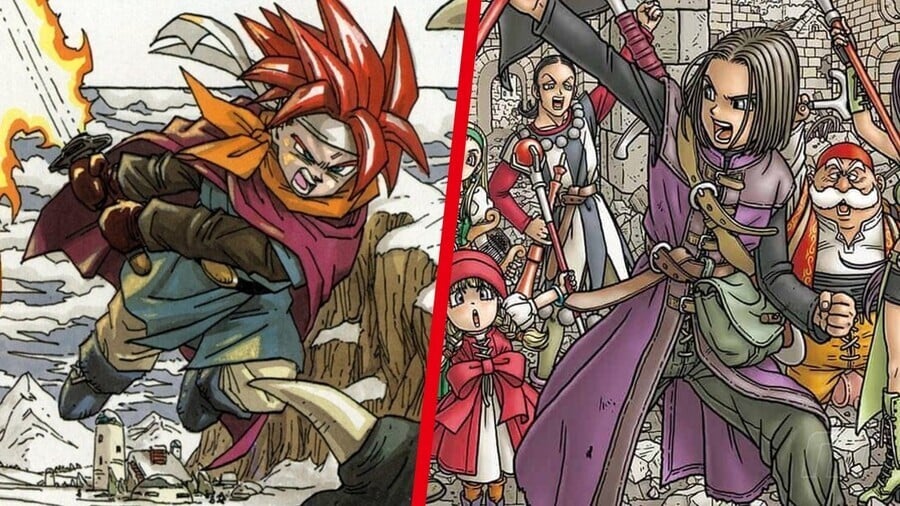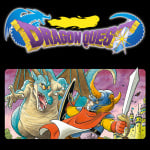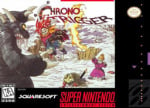The artist is, of course, most well-known for his work on Dragon Ball, Dr. Slump , Lady Red , and Sand Land (which is being adapted into a video game coming in April) among many other manga. And Toriyama's then-editor at Weekly Shonen Jump, Kazuhiko Torishima, as he told Forbes , recommended the artist to one Yuji Horii — another writer at Shonen Jump who then worked at Enix — to help work on a video game: Dragon Quest .
The reason I fell in love with Dragon Quest is because of Toriyama's art. All of the same colourful charm and heroic, powerful character designs fit perfectly with these beautiful fantasy worlds, and because of that, Dragon Quest feels inseparable from Toriyama's art. I saw the box art for Dragon Quest VIII on the shelf and instantly felt the infectious spirit of adventure and charm. I bought it, and the rest is history.
The same energy from Dragon Ball and Toriyama's other work is here in Dragon Quest, wrapped in a fantasy veneer. Silent protagonists are given a whole identity thanks to Toiryama's art — the proud heroism of Dragon Quest III 's hero is matched with big, spikey hair and contrasting blue and yellow colours. Dragon Quest IV 's female design is one of my all-time favourites, with big '80s-style curls and a body suit to match. And the humbleness of Dragon Quest VIII 's hero with his yellow jacket, definitely evokes some Goku.
Toriyama definitely has a set of styles when designing characters, but their looks are timeless. Bianca's little ponytail from Dragon Quest V gives her the 'girl next door' vibes while also bringing some sass to her designs; Alena's mage-like outfit disguises a very passionate and very strong monk-like character in Dragon Quest IV. And let's not forget Sylvando, the star of Dragon Quest XI , where the design blends performing arts with the physique of a warrior.
The reason I fell in love with Dragon Quest is because of Toriyama's art.
His work shines best in the franchise's iconic monster designs, though. What you see is what you get with a Dragon Quest monster. The Great Sabrecat is a huge feral cat with leopard spots and sabre tooth tiger teeth, while the Hacksaurus is just a giant lizard brandishing an axe. And if someone says the phrase "killing machine" to me then I'll always think of their Dragon Quest design first and foremost. And we're not going to forget about the Slime, either — Toriyama's characters, particularly the male ones, often look pretty serious, but this little fella? He's anything but serious; just look at him!
While Toriyama's art for Dragon Quest is probably his most significant in the gaming sphere, he also had a huge hand in one of the most beloved RPGs of all time as a member of the Dream Team — Chrono Trigger . Toriyama's name stands proudly alongside Dragon Quest creator Horii, Final Fantasy creator Hironobu Sakaguchi, FF composer Nobuo Uematsu, and battle designer Kazuhiko Aoki. What a lineup.
Toriyama's art for Chrono Trigger is amazing. It captures movement so well, just like the Dragon Ball manga does, and just as the Dragon Quest box art does, too. But with a wider scope of character designs, monster shapes, and environments thanks to the different time periods, Toriyama's work shines.
Robo is one of the coolest-looking robots I've seen, but like so much of his other art, it's got a real simplicity to it. Robo is a little rusty and a little old, after years of being abandoned and deactivated. He's from a dystopian future, and the little scratches and scrapes on his design, along with the colours used on him, really evoke that.
Magus, too, evokes so many tropes you'd associate with a villain character — dark colours, pointed features, a huge red cape — but there's also something magical and mystical about him. And it's hard to deny he doesn't just look cool as heck.
I can't talk about Chrono Trigger's art without talking about my favourite piece, though; the campfire scene. The pixel art scene in the game is one of the most memorable, but the official art — taken from the Player's Guide from the PlayStation rerelease — captures the warmth and comfort of that scene, but also the dangers of the forest. It's all coloured in yellow, green, and black, capturing the stark illumination a campfire would bring to a nighttime scene.
via Chrono Compendium / Square Enix I'm just skimming over some of the best here, but even from my cherry-pickings, it's easy to see how Toriyama inspired generations of artists. Ken Sugimori's early work on the Pokémon series evokes the same spirit as Toriyama's early work on Dragon Ball and Dragon Quest. The blended colours, sharp lines, and expressive eyebrows really help draw a connecting line between the two art styles — as pointed out by Tokyo Game Life on Bluesky .
It doesn't stop at Pokémon, though. The Big N's very own mascot, Mario, was inspired by Toriyama's work in Dr. Slump, particularly the character of Arale. Mario's movements and proportions were inspired by the little robot girl Arale, something which Shigeru Miyamoto hasn't been shy about sharing.
In a 1996 interview about Super Mario 64 , the game designer responded to a question about the plumber's "centre of gravity" being "in the hips" (from a strategy guide, translated by shmuplations ):
"You’ve got a good eye. (laughs) The area around his hips is a big “joint” that controls which way his body moves. We created all his movements from that point of origin: when he accelerates and inclines forward, when he turns and leans left or right, etc. So Mario sort of runs like Arale-chan, with the correct sense of weight in the body."
The show's intro should give you enough of an idea of just what inspirations Miyamoto took from Arale-chan.
Sonic the Hedgehog 's 'Super Sonic' transformation, meanwhile, was heavily inspired by the Super Saiyan transformations from the original Dragon Ball Z manga — the first transformation took place in 1991, and while the similarity could just be a coincidence, it's striking, with spikier hair and a bright gold colouring used in both transformations.
Toriyama's death has rightly had a huge impact. We're mourning one of the most creative and iconic manga artists of this generation. Without Toriyama, we probably wouldn't have Dragon Quest or Chrono Trigger. And his art has inspired countless other mediums, artists, and more.
If you're going to celebrate Toriyama's life and work, you couldn't do any better than returning to the source, reading his work, looking at his art, or by firing up a Dragon Quest game, Chrono Trigger, or even Blue Dragon (another game he worked on with Sakaguchi). We've lost a great artist who brought life to the page and made action readable and accessible to all.

 Watch on YouTube
Watch on YouTube





